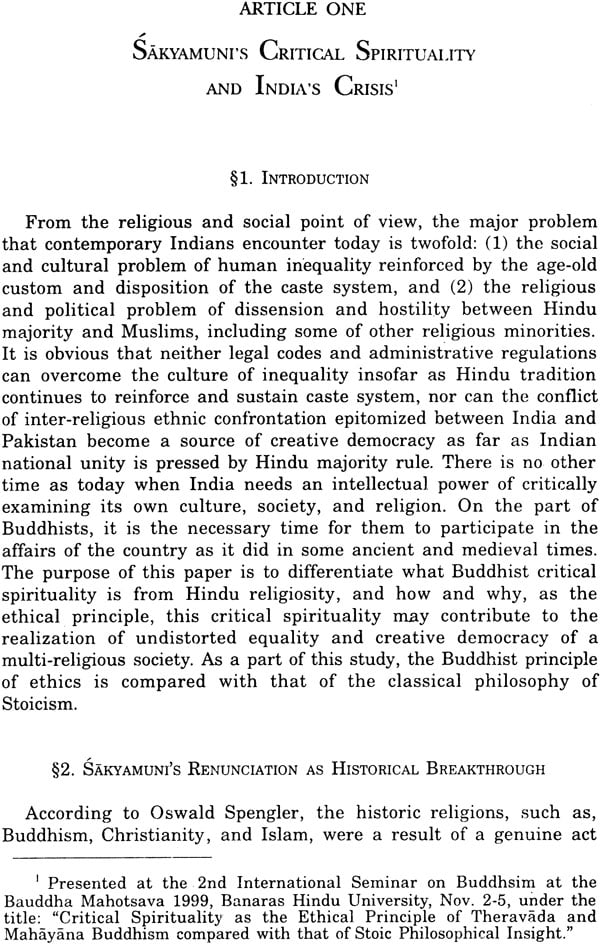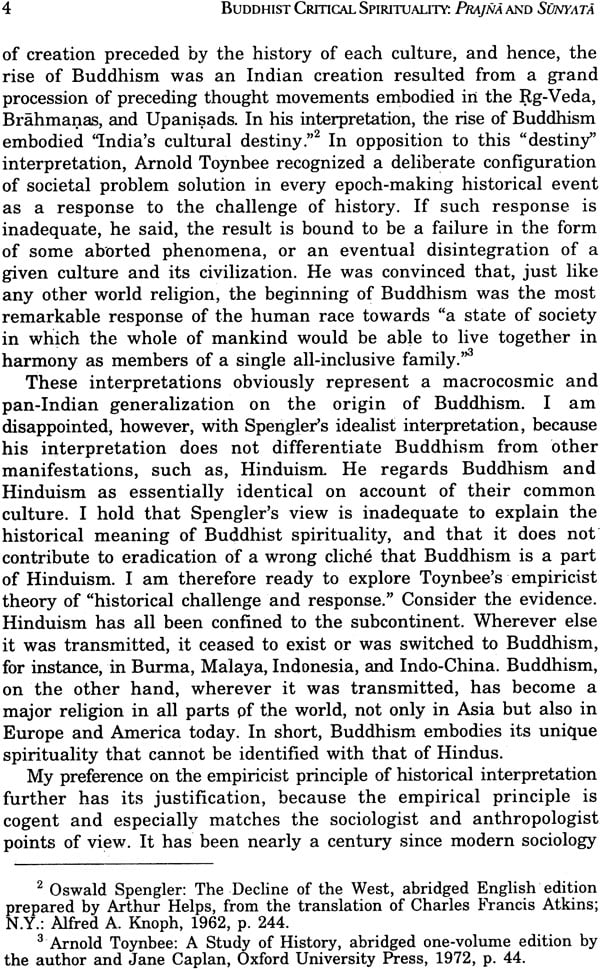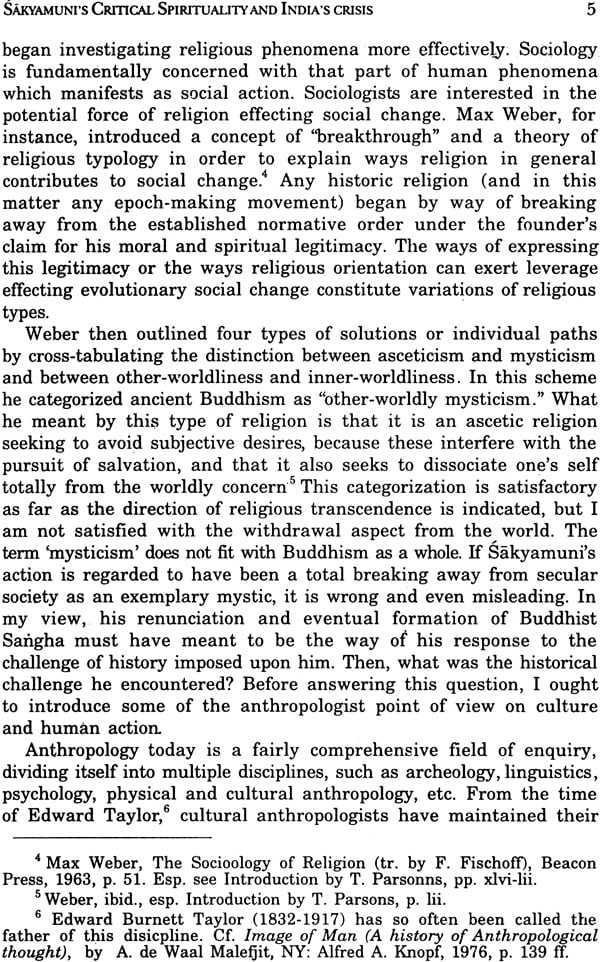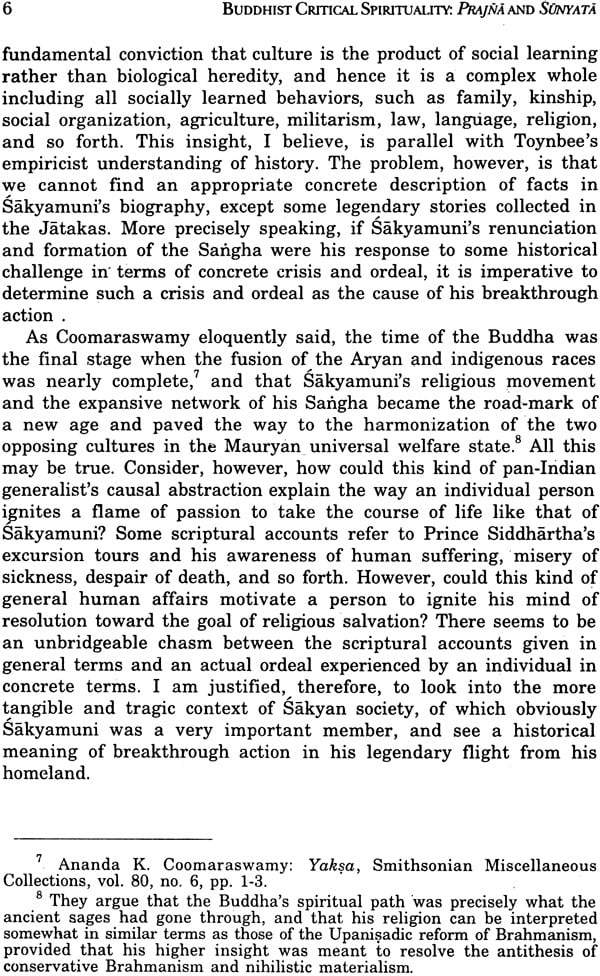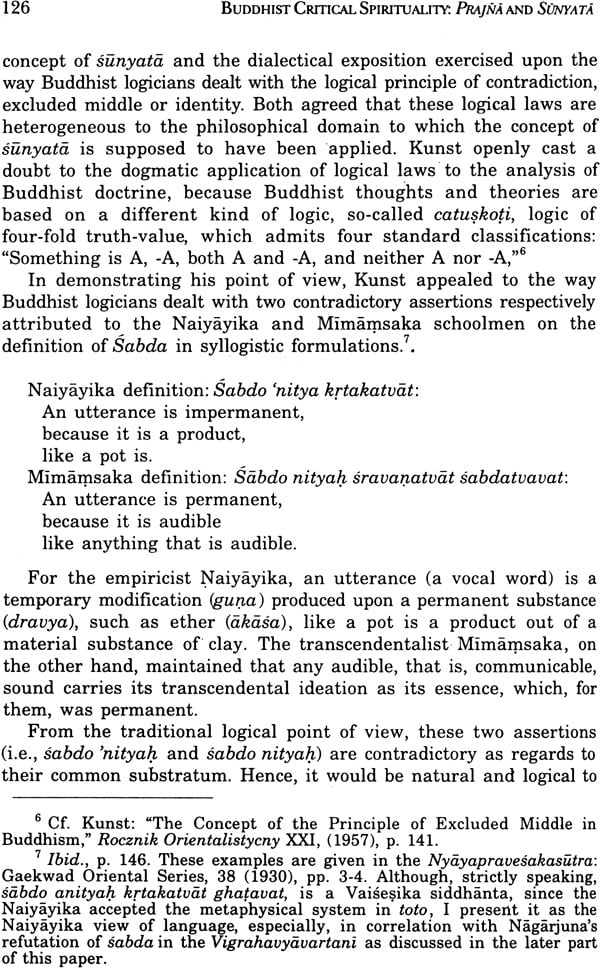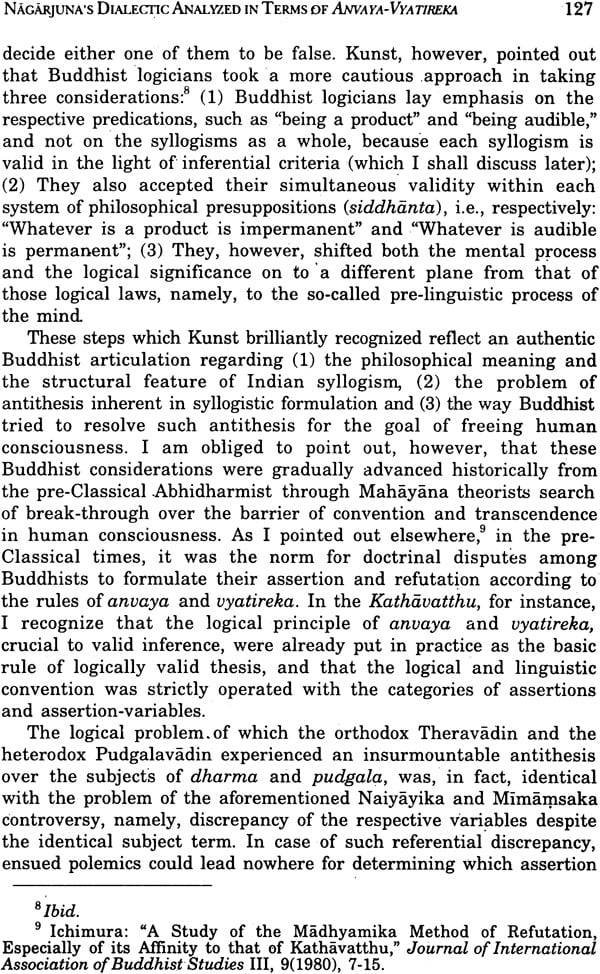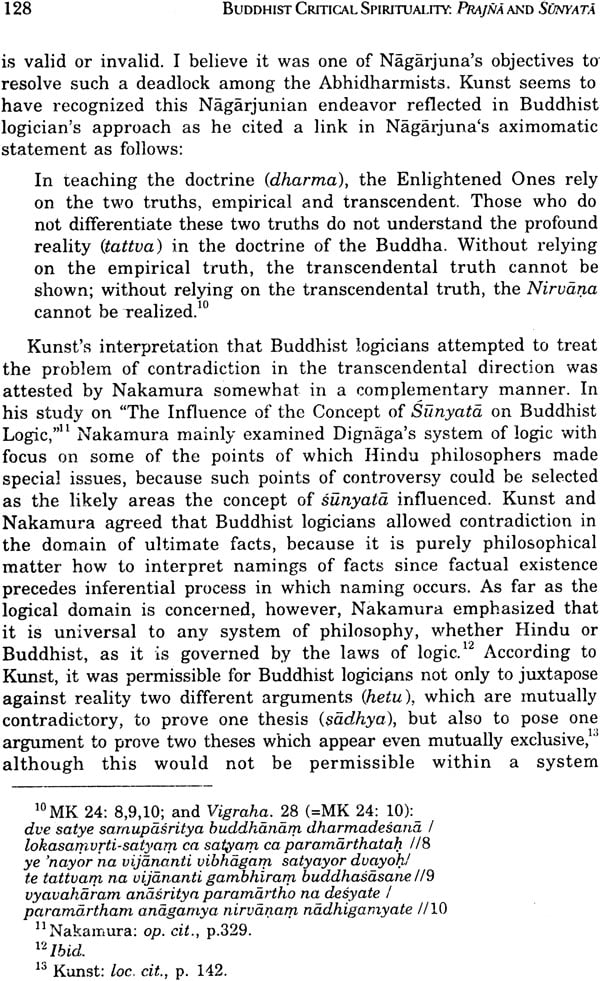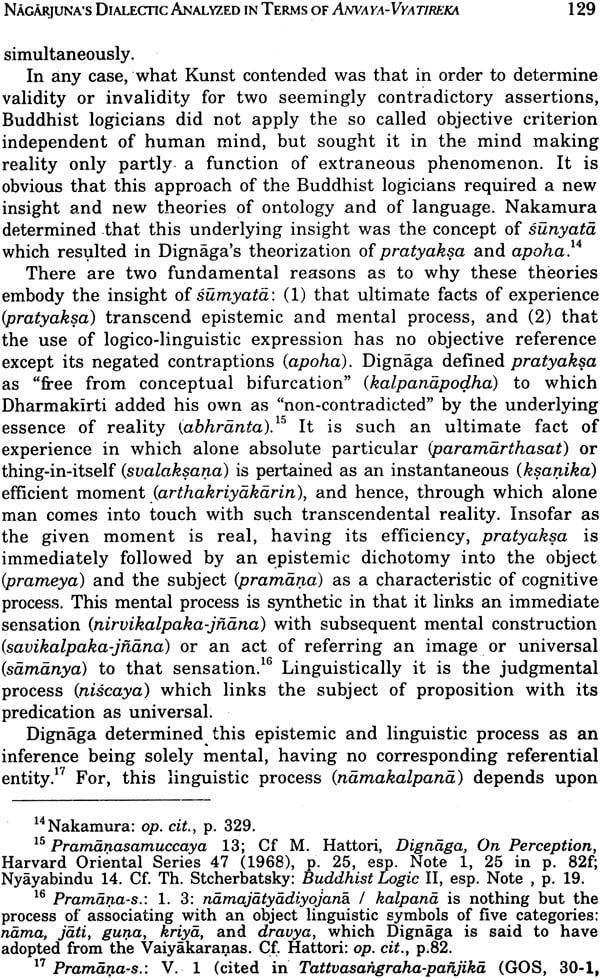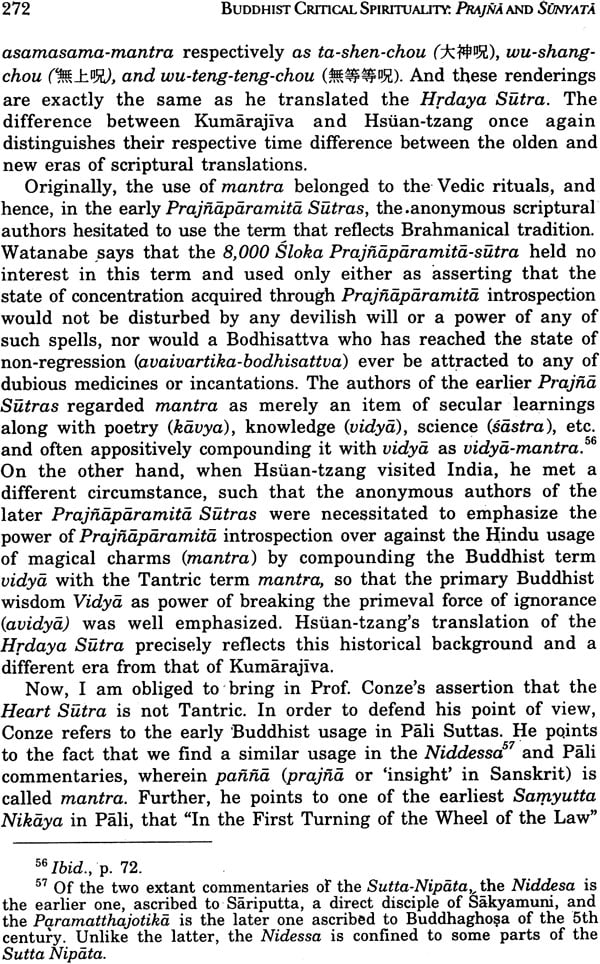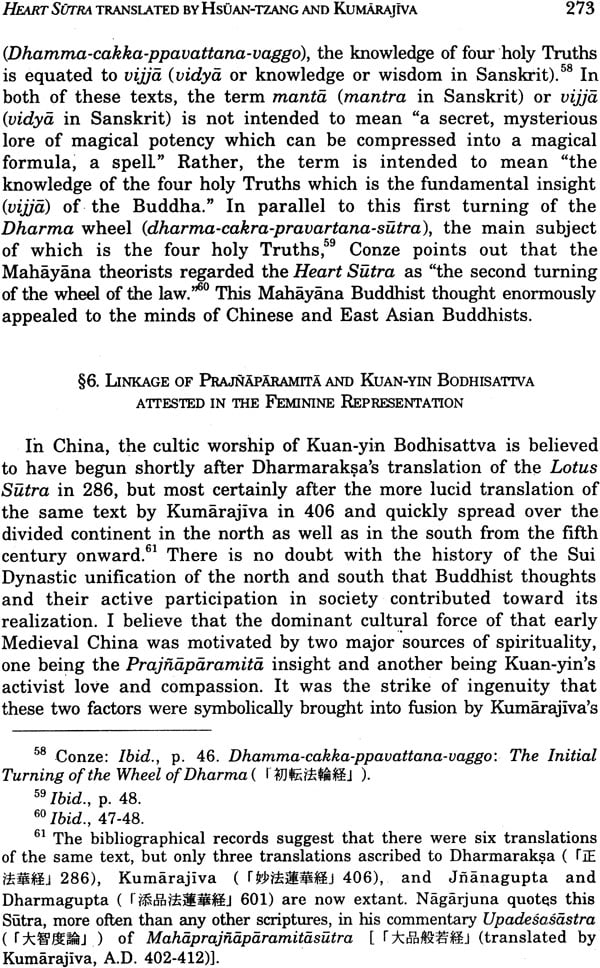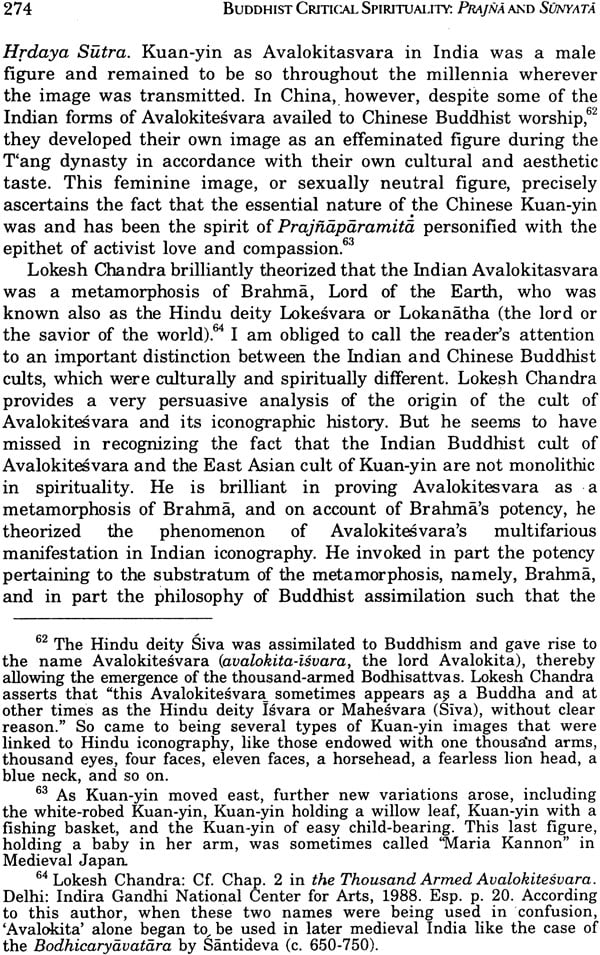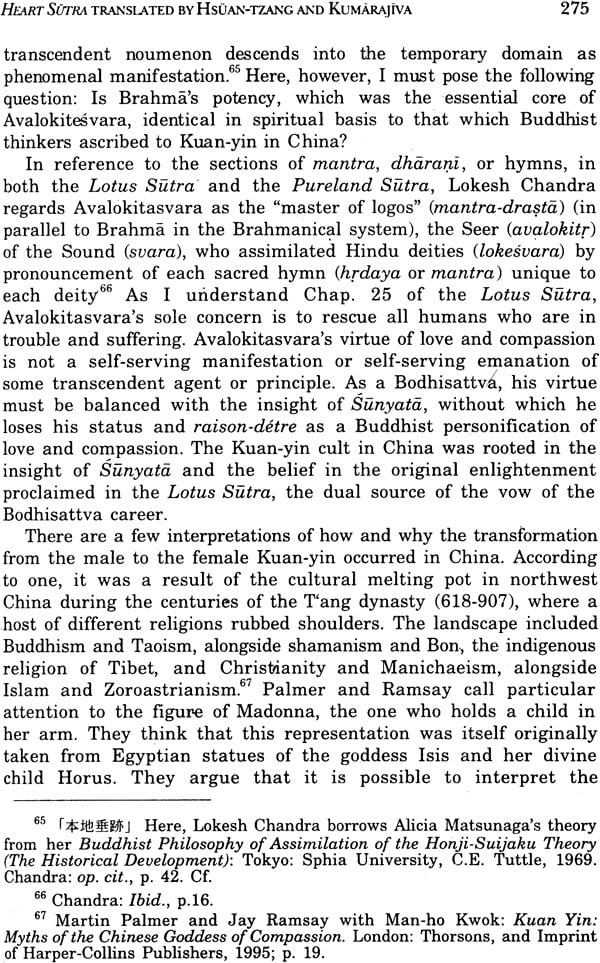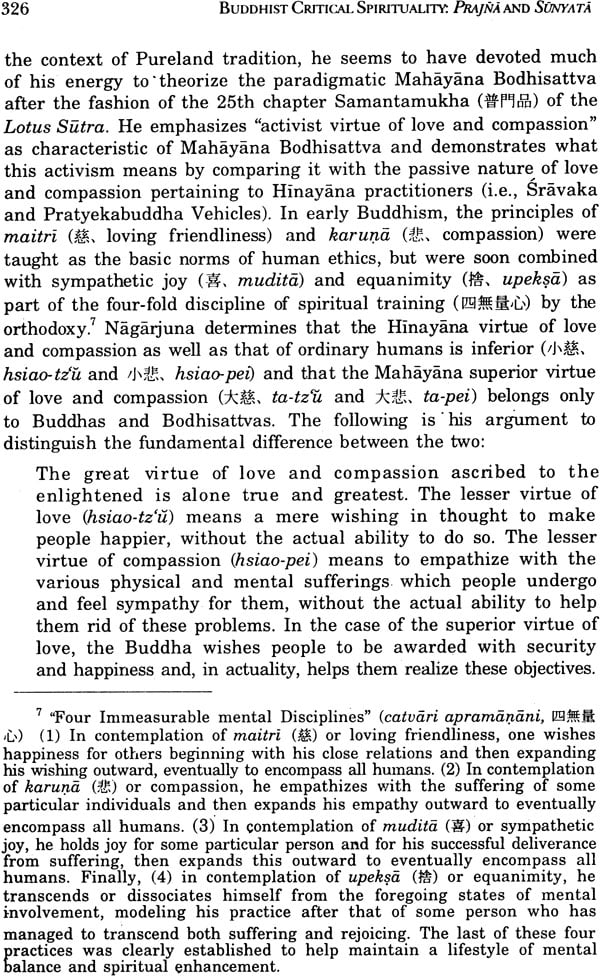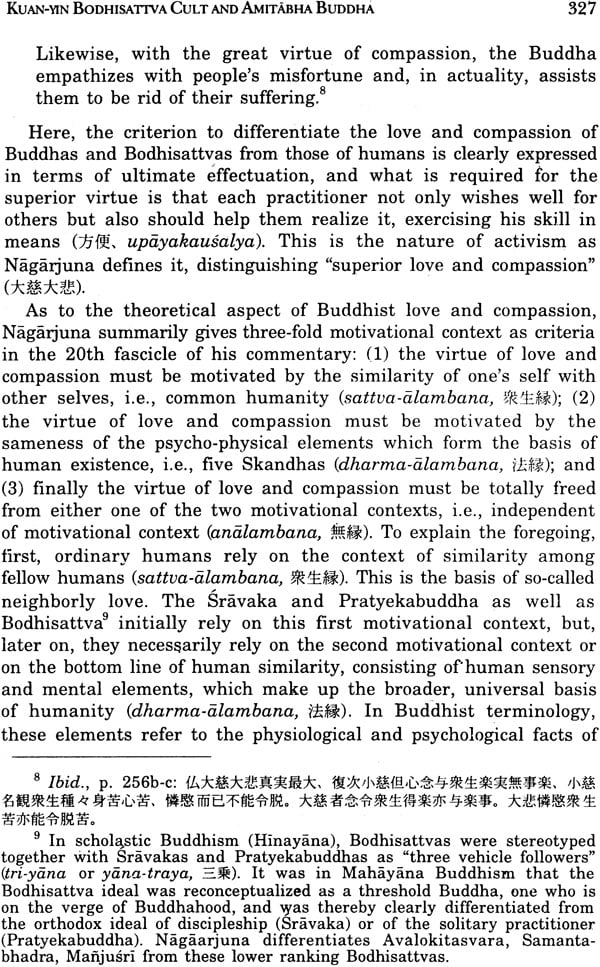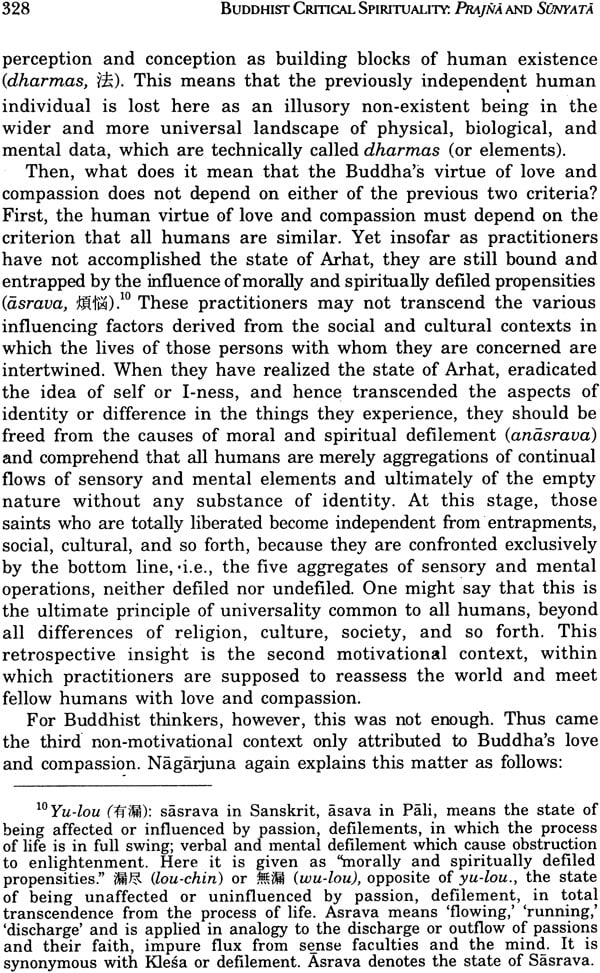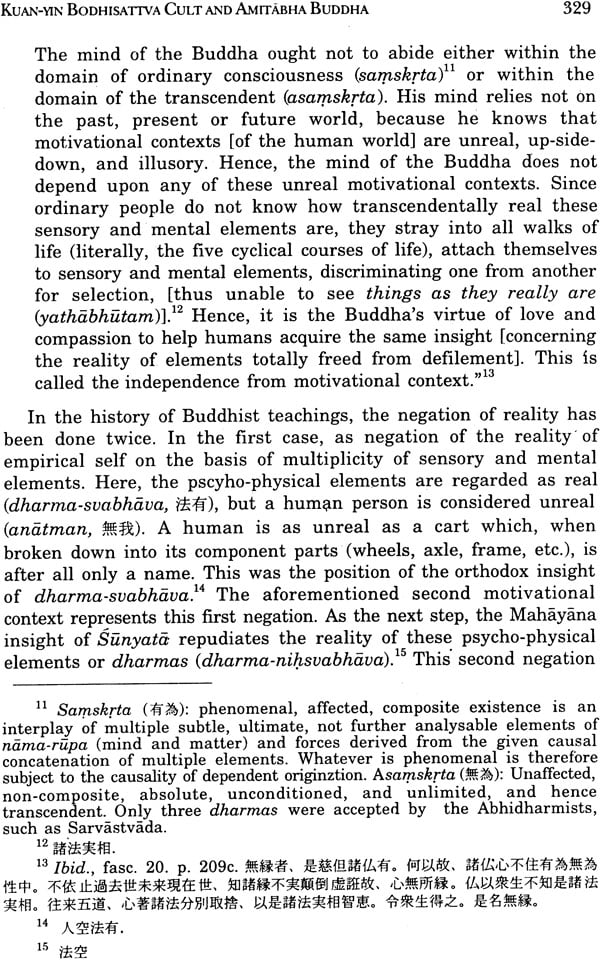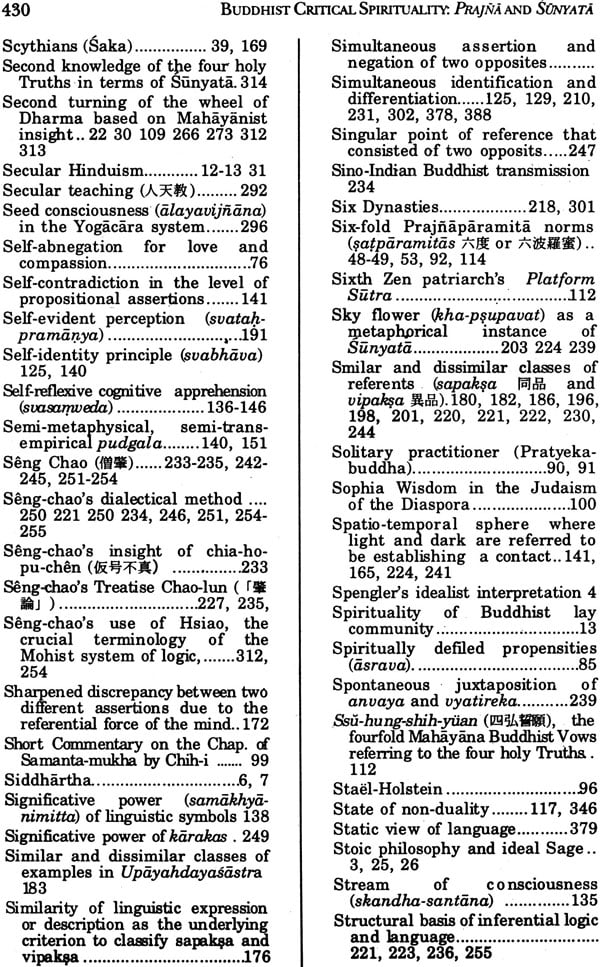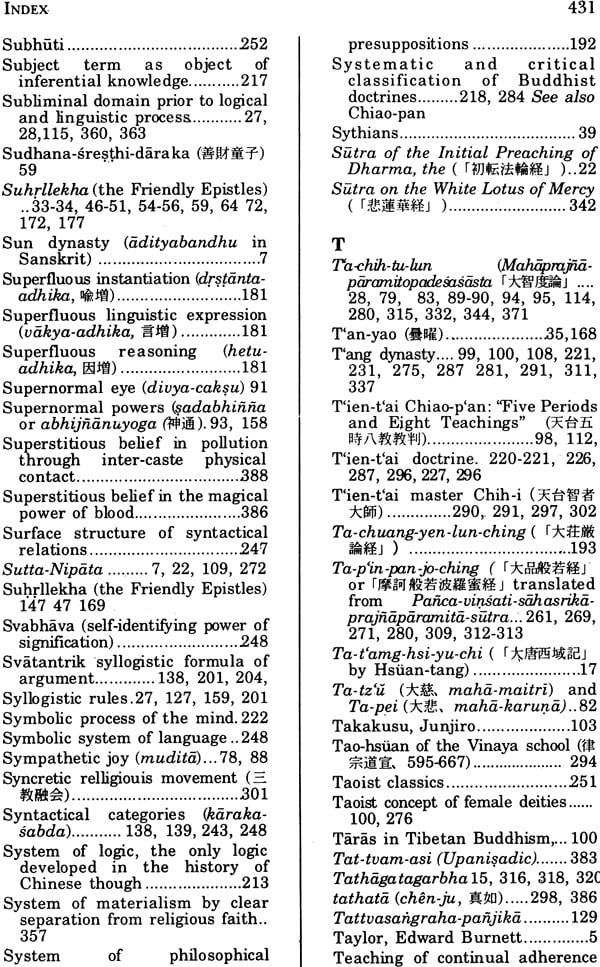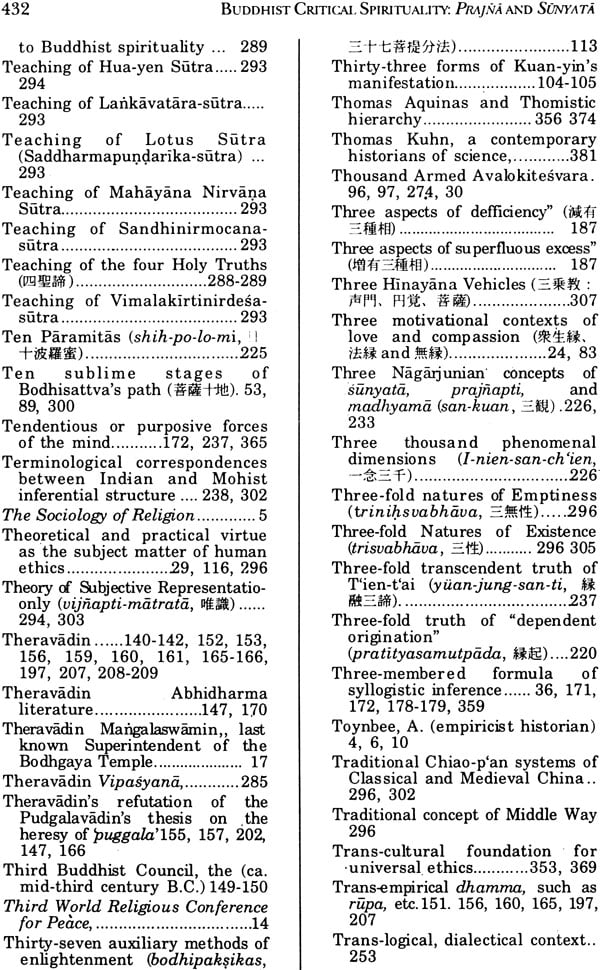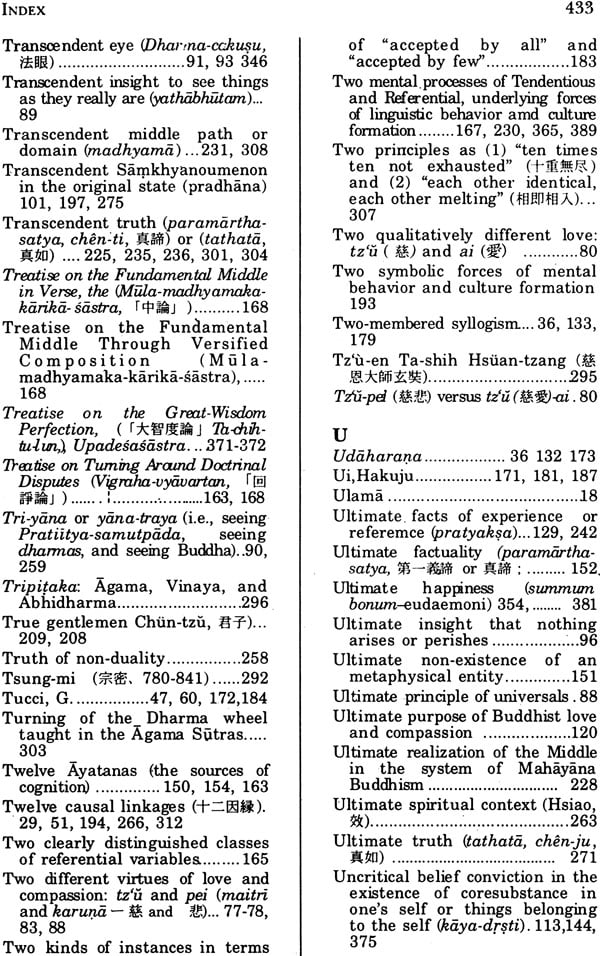
Buddhist Critical Spirituality: Prajna and Sunyata
Book Specification
| Item Code: | IDC129 |
| Author: | Shohei Ichimura |
| Publisher: | Motilal Banarsidass Publishers Pvt. Ltd |
| Language: | English |
| Edition: | 2001 |
| ISBN: | 9788120817982 |
| Pages: | 452 |
| Cover: | Hardcover |
| Other Details | 8.8" X 5.5" |
| Weight | 710 gm |
Book Description
From the Jacket
With the ending of a century marked by broad ideological conflict, post-modern philosophers, including those who quest the nature of human spirituality, stand at a turning point. Will they usher in a new renaissance to curb the rising tides of skepticism and rising religious fervor that threaten to undermine the rational autonomy of humanity?
This book comprises fifteen research articles primarily based on the discipline of Indian and Buddhist Studies. The collection is designed to propose a Buddhist philosophy of religion That the insight of Prajna and Sunyata initiates a future religion which is freed both from conflict between reasoning and believing, and from goal-oriented cycles of life. It addresses transformation from the conflict-ridden quest for a supreme being, to the search for a non-theistic nature of spirituality that provides a foundation for universal human happiness and salvation. For the discipline of Buddhist Studies, this collection also demonstrates the productive value of drawing upon cross-cultural and cross-racial literary sources and traditions.
Dr Shohi Ichimuraa trained in Zen Study at Komazawa College in Tokyo (B.A., 1955) and performed graduate studies in History and Philosophy of Religion (1956-58) and Sanskrit and Indian Studies at Harvard University, (M.A., 1960). He received his doctorate in Buddhist Studies from the University of Chicago, department of South Asian Languages and Civilization (Ph.D., 1972). He has been the director of the North American Institute of Zen and Buddhist Studies since 1993.
Introduction
This volume is a collection of fifteen essays which were presented by this author each at different occasions during the past decade. While each essay is complete for the meaning of its own title, some of the articles refer to Indian and South Asian Buddhism, and some others to Chinese and East Asian Buddhism. The essays are arranged in four major sections, irrespective of their chronological order, under the over-all title: "Buddhist Critical Spirituality: Prajna and Sunyata," on the ground that each of them is concerned with the religious nature of Buddhism, its philosophy and history.
In general, the phrase "religious nature" can be termed as "religiosity," thus calling the religious nature of human kind as "human religiosity" or the nature of Buddhism as "Buddhist religiosity." For the title of this book, however, I applied another term "spirituality," which is more prevalent in America as its equivalent, despite the difference of the connotations of these terms. Here, spirituality refers to a capacity and tendency that is innate and unique to all human individuals. It is due to this spirituality or religiosity or religious nature inherent in all humans that an individual is prompted to move to knowledge, faith, meaning, hope, transcendence, connectedness, love and compassion.
Studying the origin and development of the major existing religious traditions of the world, we are compelled to recognize two different types of spirituality. On the one hand, there is the type of spirituality pertinent to theistic or mono-theistic religion. This spirituality prompts individuals to believe in the existence of the transcendent being and the religious redemption in terms of the grace of that being. On the other hand, there is the type of spirituality that prompts individuals to acquire the knowledge that dispenses with the belief of such a being not only with the universe but also with the belief of human individual soul or self. And yet this spirituality finds the way of realizing the state of emancipation from human imperfection and suffering in terms of self-realization Buddhism belongs to the latter type of spirituality, perhaps, being only a singular example of non-theistic religion.
The adjectival term "critical" has two different meanings in general. One derives from "crisis" which represents a turning point or decisive moment or crucial time of a change or a state of affair. A good example is the name of "critical theology" coined by a group of theologians during the second quarter of the century. Another meaning of "critical" derives from "critic" (or "to criticize") which refers to a reasoned opinion on any subject matter involving a judgment of its value through evaluation or analysis with respect of its merit and demerit. Needless to say, the term here as "critical spirituality" refers to the latter usage, as in the case of a few examples, "critical analysis of linguistic convention," "critical examination of perception," or "critical investigation of philosophical systems," and so forth. What is common in these usages is the fact that the adjectival term implies rational and impartial treatment of a given subject matter.
Speaking broadly, every religion, more or less, has a critical attitude towards life and society and advocates its own belief and thought as well as a set of norms of action as an answer of its spirituality to the critical evaluation of life and society. Accordingly religion in general is strongly assertive of its belief and thought and likely will not allow a critical re-evaluation of its principle and practice within its own community. In this respect, the Buddha's emphasis on the principle of critical thought and attitude is evident in his admonition given to his disciples. He is said to have warned them not to blindly believe in whatever he taught, and he demanded them to critically examine whatever he said by their own thought and practice before accepting it. To those of us who are concerned with the present day world as torn asunder to all factions pulled by different religions and cultures, races and ethnicities, this practical admonition given by Sakyamuni rings loud and clear.
Sakyamuni's emphasis on his critical spirituality, however, meant to go beyond the practical level of religious belief and spirituality. During the decade of fifty's, T. R. V. Murti published a book entitled: The Central Philosophy of Buddhism (1955) and created a new sensation among the post-war scholars of Buddhist Studies. In his daring attempt to parallel Madhyamika philosophy and modern Western philosophy, he followed the way Stcherbatsky briefly attempted in The Conception of Buddhist Nirvana (1927), namely, the ultimate goal to which Buddhist critical spirituality leads. Murti elaborated his writing into a full detailed monograph. At the time when the East-West philosophical and cultural interaction just began, his philosophical interpretation was especially welcomed as a viable approach to the new era of Buddhist Studies. Murti emphasized that the critical insight of the Buddha and Madhyamika like Nagarjuna applied the dialectical method. Of treatment to metaphysical problems. He contended that this can be elucidated to the Westerner's min by comparing it with the critical philosophy and dialectical method of Kant, Hegel, and Bradley in the way they applied it to dealing with similar metaphysical problems, say, a-priori categories of the mind and the idea of thing-in-itself.
Philosophically, however, the twentieth century began with an anti-metaphysical movement. The so-called analytical philosophy of the early century asserted that the previous metaphysical problems ought to be approached differently through critical examination of language itself. Bertrand Russell and others thought that metaphysical problems arose due to misuse of language, and hence, some of the problems can be dispensed with. Thus, the clarification of linguistic forms and usages by way of logical analysis became the sole subject of investigation of Analytic Philosophy. Previously, "a-priori category" and "thing-in-itself" were central subjects to deal with the problem of epistemology. For Kant for instance, "thing-in-itself" was the ultimate basis of justification for the validity of knowledge with respect to our empirical perceptions and universal forms of the mind in which things appear. Sensation (say color, sound, etc.) gives an individual idea, while mathematical theory gives a necessary and universally valid perception in reference to the actual world. But these two are ultimately detected to be merely different stages of phenomenal appearance, and "thing-in-itself" in the actual world would never become known.
Dissociating themselves from these metaphysical problems, philosophical movements of the new century turned to the problems of logic and language. By the 1930's, around the time when Stcherbatsky's book came out, the original trend of analytical philosophy was divided into the movement of logical positivism in Europe and that of ordinary language philosophy of England, to both of which the subject matter of philosophy was no longer the idea of reality outside language or the form of representation in the mind. The two main streams of philosophers discarded what was previously central to philosophy, i.e., thing-in-itself and a-priori forms of the intellect. As a result, the methodology that Stcherbatsky and Murti adopted was to be well stranded despite some enthusiastic follow-ups in the subsequent decade or two. The logical positivists sought an ideal language that could precisely describe a given state of affair in terms of verification, while ordinary language philosophers tried through linguistic analysis to find what state of affair our ordinary language is really deemed to describe. The idea of logical positivism or search for an ideal language waned during the later half of the 20th century, while the so-called philosophy of language has waxed to become the dominant trend through diversification of ordinary language philosophy toward the enquiry of the relation between language and action or between language and mind. There was, thus, a series of developments from the idea of language as descriptive tool to that of language as action or as intent of action, and further to the new trend of the philosophy of mind and that of the referential theory of language.
Reflecting upon the history of Buddhist Studies during the past half a century, I do not find any specific parallel development of its methodology along with the contemporary philosophical trends as briefly mentioned above. Surely during the 50's and early 60's, some scholars, such as, Nakamura, Robinson, and few others, attempted to apply symbolic logic to understand Madhyamika dialectic and the syllogistic inference of Buddhist and Indian logic. It is my impression that the professional interest of the most of scholars of Buddhist Studies in the West was related to the discipline of Religious Studies. Accordingly they did not find the aforementioned discipline of linguistic philosophy or analytical philosophy to be especially interesting, in part, because their interest was more theological, and in part, because the general public did not sense an aura of spirituality in the result of these philosophical methods. Accordingly, despite the reverberation created by Stcherbatsky and Murti, Buddhist Studies has remained in good majority to be concerned with textual critique, history and culture. In theological studies, the methods of doctrinal exegesis and hermeneutic exploration were more favored, but these were not very well familiarized to scholars of Buddhist studies. The reason is that these are oriented toward biblical and theological study and interpretation and do not fit for measuring the trans-linguistic experience of Samadhi and Nirvana, nor has there been a clear set of criteria to measure the linguistic expression of transcendent insight, such as, prajna and Sunyata.
As far as my research and writing are concerned, I am obliged to admit that I have been benefitted from learning some of the Western traditional philosophy and contemporary linguistic and analytical methods of philosophy. I have also been benefitted from exploring the philosophical tradition of Sanskrit grammarians and the insight of Medieval Indian linguists. There is an enormous quantity of literary sources in these fields. I have not, however, fully affiliated my self with any one of the philosophical methods of the contemporary West, nor have I been an advocate of any one of the Indian philosophical traditions. Methodologically, therefore, I am obliged to assert that most of my researches and writings as collected in this book were accomplished by ad-hoc adoption of some methods and criteria from the aforementioned dual sources, insofar as they fit to dealing with Buddhist thoughts and insights. The Western philosophical trend has been rather too transient throughout the century, while the Indian grammatical and Hindu thoughts. Within a few years, I am planning to publish another volume under the title: Nagarjuna's Philosophy of Sunyata and Dialectic, and I am hoping to present a more comprehensive statement on the methodology of a Buddhist Study at that time.
Despite the post-war global expansion of Buddhist thought and activity, the scholarship in Buddhist Studies seems to have been still compartmentalized by being limited to their literary sources, linguistic proficiency, and culturally varied backgrounds. For instance, we have four major groups of Buddhist Studies respectively based on the textual sources of Pali, Sanskrit, Tibetan, and East Asian languages (Chinese, Korean, and Japanese). It is mainly due to the difficult linguistic barriers that an integral study program has not been sufficiently developed in academic institutions. Even today, the centers where a research scholar can pursue an integral approach are indeed limited in number. In major American universities, for instance, Pali and Sanskrit Studies have been maintained since the pre-war times, and from the 60's, the discipline of Tibetan textual study began to be incorporated for a wider, integral study program. And yet it is far from actuality insofar as the integration of East-Asian Buddhist Study and the hitherto regarded main stream of Buddhist Studies is concerned. Despite the fact that Far Eastern languages and civilization have been well established in major universities since the early 20th century, this is still the actual state of Buddhist Studies today.
My present fifteen articles are all result of cross-cultural studies of Buddhism based on the scriptural sources in Sanskrit and Pali on the one hand, and the Chinese scriptural sources. The Tibetan Tripitaka linguistically preserved the original forms of Sanskrit scriptures very well and recorded intra-Buddhist as well as extra-Buddhist polemics of the later half of Mahayana Buddhist history in India. On the other hand, the Chinese Tripitaka preserved the Sanskrit scriptures of the earlier half of Mahayana Buddhist history, especially those which reflect the formative period of Mahayana Buddhism. It is my contention that the Sino-Indian cultural interaction through Buddhism is one area that ought to be fully focused in future global Buddhist Studies. Interactions between India and China, two very different cultural and linguistic zones, ought not to be neglected in our integral study approach, because the outcome of such a study on Buddhist spirituality is far more fruitful than a study derived from a singular compartmentalized source of culture and language.
Although Chinese people are currently adopting the Communist ideology to handle their contemporary political and social problems, they are by no means an exception from human religiosity or Buddhist spirituality. I thank some of my articles demonstrate how and why the Medieval Chinese could manage to accomplish a lofty heritage of human spirituality in all forms of expression, in thought as well as action for future humanity. Nor should the current Sino-Tibetan conflict interfere with the direction of future Buddhist Studies, because, during the Yuan dynasty and subsequent periods, Tibetan and Chinese Buddhists evidenced superior and creative cooperation in the absence of contemporary ideological constriction and aggression. One of the areas of East Asian Buddhism, to which I wish to have special attention given today, is the doctrinal systematization of Buddhist thought and spirituality, so called Chiao-p'an of Medieval China. Since the times of the 5th century onward, the intellectual and spiritual endeavours of Chinese Buddhists organized a variety of philosophical systems on Buddhist doctrines. Each of these systems invariably demonstrates how and why Chinese Buddhist thinkers endeavored to accomplish their own spiritual wayfaring toward the ultimate insight of Meddle Way. It is my belief that these specimens or testaments will rekindle the minds of scholars and students toward Buddhist Studies of this new century.
In publishing this book which comprises fifteen articles, in have an earnest wish to communicate to the readers. It is concerned with the question: How could Buddhist scholars respond to the current trend of religious fervor and sentiment globally observed as having been on the rise? During those five centuries of modern times, we have regained the honor and respectability of rational human person from the Medieval theological domination of human affairs. This has been abundantly evidenced not only by the advancement of various sciences, but also by the greatest liberalization of humanity hitherto accomplished in history from the constriction imposed upon rational faculty, natural emotion, and free moral action. Some thinkers began to call our contemporary period as "post-modern era" as early as the 1970's. Crossing the mark of the twenty-first century since then, we hear this term more often and more extensively, but not necessarily with an open-handed salutation. Subversive resurgence of religious fervor seems to have been steadily undermining human rationality, blaming its imperfection and ineffectuality with the conduct of human affairs in communities, societies, or states. Where we most need workings of harmonious principle and rational reconciliation to deal with the global affairs, we seem to have been pulled asunder by religious and cultural factionalism. The lofty ideal figure of human rationality seems to have been seriously hurt along with its honor and respectability. Once again, we are obliged to look into this reactionary trend of religious fervor and sentiment and deal with it for restoring human rationality and magnanimity on the basis of critical spirituality. Future religion ought to be one which can support and sustain the rational faculty of human nature to its full capacity and honor against odds of threat and fear. I believe that the papers collected here invariably proposing this earnest appeal.
It has been a long journey for my career of study and research that began during 1950's. Throughout this journey, I have been fortunate to be acquainted with innumerable friends of good will and superior guid, to whom I owe much of benefit to advance my wayfaring. Though this is a preliminary step, I would like to include my profound thanks to those friends, many of whom I miss today with reverence. For now, may I thank Mr. R.P. Jain, director of Motilal Banarsidass, for his welcome agreement to publish this volume of my collected papers.
| Introduction | xi | |
| | ||
| | ||
| I | SAKYAMUNI'S CRITICAL SPIRITULITY AND INDIA'S CRISIS | 3 |
| 1. Introduction; 2. Sakyamuni's Renunciation as Historical Breakthrough; 3. Sakyan Tragic Fate and Sakyamuni's Renunciation; 4. Buddhist Sangha and Assimilatory Secular Hinduism; 5. Buddhism's Disappearance upon Hindu-Muslim Confrontation; 6. Critical Spirituality as Basis of Popular Kuan-yin Cult in China; 7. Sunyata as Critical Spirituality: Principle of Communication and Reconciliation; 8. Conclusion. | ||
| II | NAGARJUNA'S HISTORICITY ON THE BASIS OF SUHRLLEKHA AND RATNAVALI | 33 |
| 1. Introduction; 2. Nagarjuna's Dates reviewed from Literary Contexts; 3. Nagarjuna's Dates reviewed from Historical Contexts; 4. Satavahana Kings versus Saka Satraps: Political and Cultural Conflict; 5. Suhrllekha and Ratnavali respectively written for Hinayana and Mahayana Orientations; 6. Governing Principles inculcated in Suhrllekha and Ratnavali; 7. Points of Historical Reference for Nagarjuna's Dates in Suhrllekha and the Ratnavali; 8. Nagarjuna's Biography and Southern Kosala; 9. Conclusion. | ||
| III | BUDDHA'S LOVE AND HUMAN LOVE WITH FOCUS ON KUAN-YIN BODHISATTVA | 75 |
| 1. Introduction; 2. Love and Compassion through Four Contemplative Disciplines; 3. Three Motivational Contexts of Buddhist Love and Compassion; 4. Buddha and Bodhisattva differentiated as to their Love and Compassion; 5. Buddhist Cult of Kuan-yin Bodhisattva and Human Cultures; 6. Kuan-yin Bodhisattva depicted in the Lotus Sutra; 7. Kuan-yin Bodhisattva and the Prajna Heart Sutra; 8. Kuan-yin's Love and Compassion based on the Transcendent Insight of Sunyata; 9. Conclusion. | ||
| NAGARJUNA AND MADHYAMIKA DIALECTIC OF CRITICAL SPIRITUALITY | ||
| IV | NAGARJUNA'S DIALECTIC ANALYZED IN TERMS OF ANVAYA-VYATIREKA | 123 |
| 1. Introduction; 2. Buddhist Concept of Sunyata and Its Influence upon Buddhist Logic; 3. Buddhist Reduction of the Five-Membered Syllogism to Two-Membered Formula; 4. Logical Limit and Dialectical Method upon Anvaya and Vyatireka; 5. Nagarjuna's Refutation of Naiyayika Logic: Dialectical Context versus Logical Context; 6. Conclusion. | ||
| V. | ABHIDHARMIKA LOGICAL CRISIS AND MADHYAMIKA DIALECTICAL SOLUTION | 147 |
| 1. Introduction; 2. Communication Breakdown as expressed in the Kathavatthu; 3. The Problem of Logical Deadlock in the Kathavatthu; 4. Solution by the Madhyamika Dialectical Method; 5. The Common Structural Foundation Logic and Dialectic; 6. Conclusion. | ||
| VI | NAGARJUNA AND UPAYAHRDAYASASTRA (FANG-PIEN-HSIN-LUN) | 171 |
| 1. Introduction; 2. Similar (Sapaksa,) and Dissimilar Instance (Vipaksa,); 3. Logicality of Drstantra: A Sapaksa accepted by all but a Vipaksa by a few; 4. Linguistic Excellence (Vakyaprasamsa) and Three-Membered Syllogism; 5. Consideration of Nagarjuna's Exchange of Arguments with the Naiyayikas; 6. Further Consideration of Nagarjuna's Exchange of Arguments with the Naiyayikas; 7. Conclusion. | ||
| VII | STRUCTURAL LINKAGE BETWEEN NAGARJUNA'S DIALECTIC AND LOGIC | 189 |
| 1. Two Kinds of Logical Impasse and Nagarjuna's Dialectic; 2. Logical Dispute cited as Topic 2 in the Kalpanamanditika (Ta-chuang-yen-lunching,) 3. The Meaning of Metaphorical Examples in Nagarjuna's Dialectic. | ||
| CHINESE BUDDHIST CRITICAL SPIRITUALITY AND ITS CULTURE | ||
| VIII | THE SIGNIFICANCE OF CHINESE BUDDHIST PHILOSOPHY FOR THE CONTEMPORARY WORLD | 207 |
| 1. Introduction; 2. Confucian and Mohist Thought on Moral and Cultural Problems; 3. Confucian and Mohist Contribution to Logic and Language; 4. Comparison between Chinese and Indian Logic; 5. Chinese Buddhist Contributions to Logic and Linguistic; 6. Logical and Dialectical Structures; 7. Seng-chao's Paradoxical Argument and T'ien-t'ai's Philosophy of Sunyata,. 8. Conclusion: Chinese Buddhism. And Its Contribution. | ||
| IX | THE CHINESE MADHYAMIKA SENG-CHAO'S PARADOXICAL METHOD OF ARGUMENT | 233 |
| 1. Introduction; 2. Structural Identity of Inferential Logic between Indian and Chinese Systems; 3. Logical Context and Dialectical context and Respective Dual Criteria; 4. Seng-chao's Paradoxical Argument based on Two Criteria of the Dialectical Context; 5. The Dialectical Meaning of Reductio-ad-absurdum and Paradoxical Method of Argument; 6. Seng-chao's Paradoxical Argument and Mohist Logical Principle of Hsiao, 7. Conclusion. | ||
| X. | HEART SUTRA TRANSLATED BY HSUAN-TZANG AND KUMARAJIVA AND ITS CULTURAL IMPACT | 257 |
| 1. Introduction 2. The Prajna-hrdaya-sutra within the entire Prajna-paramita Literature; 3. The Linkage of the Prajna Hrdaya Sutra and Kuan-yin Bodhisattva; 4. Hsuan-tzang's and Kumarajiva's Heart Sutra Paralled; 5. Vidya and Mantra in Hsuan-tzang's and Kumarajiva's Heart Sutra; 6. Lonkage of Prajnaparamita and Kuan-yin Bodhisattva attested in the Feminine Representation; 7. The principle of Reconciliation embodied in the Hrdaya Sutra; 8. Conclusion. | ||
| XI | CRITICAL CLASSIFICATION OF BUDDHIST DOCTRINES ART ITS FUTURE | 283 |
| 1. Re-evaluation of Chinese Medieval System of Buddhist Philosophy; 2. The Meaning of Chiao-p'an as Buddhist Doctrinal Classifications; 3. Chiao-p'an Theoretical Structuring of the Linkage between Vyavahara and Paramartha; 4. The Middle Position depicted as Ultimate and Perfect Teaching; 5. Conclusion: Chiao-p'an Study and Bruno Petzold's Life Work | ||
| BUDDHIST CRITICAL SPIRITUALITY AND CONTEMPORARY WORLD | ||
| XII | BUDDHIST CRITICAL SPIRITUALITY IN INDIA AND THE WORLD TODAY | 305 |
| 1. Introduction; 2. Buddhist Spirituality versus Hindu Spirituality; 3. Sunyata as Foundation of Chinese Buddhist Spirituality; 4. Mahayana Critical Spirituality epitomized in Prajna Heart Sutra; 5. Japanese Buddhist Critique of Hindu Religious Thought; 6. Dialectical Negation as Buddhist Critical Spirituality; 7. Conclusion. | ||
| XIII | KUAN-YIN BODHISATTVA CULT AND AMITABHA BUDDHA | 323 |
| 1. Introduction; 2. Kuan-yin Bodhisattva and the Buddha: their Virtue of Love and Compassion; 3. Kuan-yin Cult and its Theoretical Basis in the Prajna Scriptures; 4. Kuan-yin's Activism in the Cult and its Practical Basis in the Lotus Sutra; 5. Reconciliation of Prajna Insight and Activist Virtue of Love and Compassion in Kuan-yin Cult; 6. Conclusion. | ||
| XIV | NATURAL LAW AS BASIS OF COMMUNICATION BETWEEN THEISTIC RELIGIONS AND NON-THEISTIC BUDDHISM | 351 |
| 1. Introduction; 2. Natural Law and the World of Nature; 3. Espousal and Schism of Natural and Divine Laws in Modern Times; 4. Cause of Communication Breakdown and Buddhist Solution; 5. Logic of Catuskoti and Buddhist Insight; 6. Buddhist and Classical Thoughts of Nature; 7. Conclusion: Necessity of Open Comparative Approach. | ||
| XV | BUDDHA-DHARMA AND NATURAL LAW TOWARDS A TRANS-CULTURAL UNIVERSAL ETHICS | 365 |
| 1. Introduction; 2. The Need for the Conscious Choice of A Theoretical Basis of Ethics; 3. The World of Nature and Moksa in Relation to Human Ethics; 4. Buddhist Dual Truth: Trans-Empirical and Conventional; 5. Logico-Linguistic Criterion for Demarcating Dual Truth; 6. The Trans-cultural foundation within the Dual Truth Structure; 7. Fundamental Ethical Motive of the Buddha; 8. Conclusion. | ||
| | ||
| BIBLIOGRAPHY | 391 | |
| INDEX | 407 |
